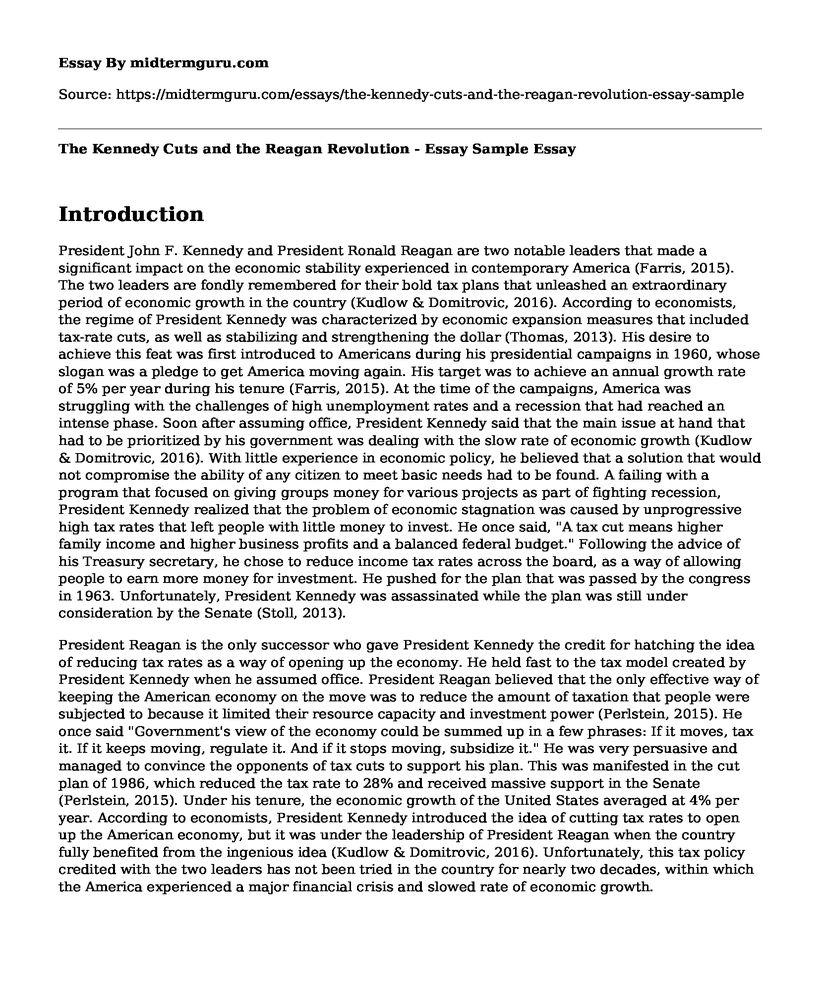Introduction
President John F. Kennedy and President Ronald Reagan are two notable leaders that made a significant impact on the economic stability experienced in contemporary America (Farris, 2015). The two leaders are fondly remembered for their bold tax plans that unleashed an extraordinary period of economic growth in the country (Kudlow & Domitrovic, 2016). According to economists, the regime of President Kennedy was characterized by economic expansion measures that included tax-rate cuts, as well as stabilizing and strengthening the dollar (Thomas, 2013). His desire to achieve this feat was first introduced to Americans during his presidential campaigns in 1960, whose slogan was a pledge to get America moving again. His target was to achieve an annual growth rate of 5% per year during his tenure (Farris, 2015). At the time of the campaigns, America was struggling with the challenges of high unemployment rates and a recession that had reached an intense phase. Soon after assuming office, President Kennedy said that the main issue at hand that had to be prioritized by his government was dealing with the slow rate of economic growth (Kudlow & Domitrovic, 2016). With little experience in economic policy, he believed that a solution that would not compromise the ability of any citizen to meet basic needs had to be found. A failing with a program that focused on giving groups money for various projects as part of fighting recession, President Kennedy realized that the problem of economic stagnation was caused by unprogressive high tax rates that left people with little money to invest. He once said, "A tax cut means higher family income and higher business profits and a balanced federal budget." Following the advice of his Treasury secretary, he chose to reduce income tax rates across the board, as a way of allowing people to earn more money for investment. He pushed for the plan that was passed by the congress in 1963. Unfortunately, President Kennedy was assassinated while the plan was still under consideration by the Senate (Stoll, 2013).
President Reagan is the only successor who gave President Kennedy the credit for hatching the idea of reducing tax rates as a way of opening up the economy. He held fast to the tax model created by President Kennedy when he assumed office. President Reagan believed that the only effective way of keeping the American economy on the move was to reduce the amount of taxation that people were subjected to because it limited their resource capacity and investment power (Perlstein, 2015). He once said "Government's view of the economy could be summed up in a few phrases: If it moves, tax it. If it keeps moving, regulate it. And if it stops moving, subsidize it." He was very persuasive and managed to convince the opponents of tax cuts to support his plan. This was manifested in the cut plan of 1986, which reduced the tax rate to 28% and received massive support in the Senate (Perlstein, 2015). Under his tenure, the economic growth of the United States averaged at 4% per year. According to economists, President Kennedy introduced the idea of cutting tax rates to open up the American economy, but it was under the leadership of President Reagan when the country fully benefited from the ingenious idea (Kudlow & Domitrovic, 2016). Unfortunately, this tax policy credited with the two leaders has not been tried in the country for nearly two decades, within which the America experienced a major financial crisis and slowed rate of economic growth.
References
Farris, S. (2015). Kennedy and Reagan: Why their legacies endure. New York, Lyons Press.
Kudlow, L., & Domitrovic, B. (2016). JFK and the Reagan revolution: A secret history of American prosperity. New York, NY: Portfolio-Penguin Random House.
Perlstein, R. (2015). The invisible bridge: The fall of Nixon and the rise of Reagan. New York, NY: Simon and Schuster.
Stoll, I. (2013). JFK, conservative. New York, NY: Houghton Mifflin Harcourt.
Thomas, E. (2013). Robert Kennedy: His life. New York, NY: Simon and Schuster.
Cite this page
The Kennedy Cuts and the Reagan Revolution - Essay Sample. (2022, Oct 23). Retrieved from https://midtermguru.com/essays/the-kennedy-cuts-and-the-reagan-revolution-essay-sample
If you are the original author of this essay and no longer wish to have it published on the midtermguru.com website, please click below to request its removal:
- Essay on the Use of Economic Development as a Tool for Political Stability
- Essay on Governmental Agencies
- Research Paper on Lubbock County Government
- Inadequate Access To Clean, Safe, Drinking Water in Canada's Indigenous Communities
- Liberalism: Promoting Liberty and Equality for People in Society - Essay Sample
- Digital Age: Impact on Democracy in the 20th Century - Essay Sample
- Public Policy: A Key to Understanding Government Obligations - Essay Sample







